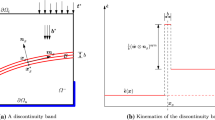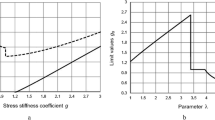Abstract
In the present paper, evolutive problems in hardening plasticity and viscoplasticity are analyzed by means of an internal variable formulation. The treatment is developed by taking advantage of the proper tools to deal with singularities and non-smooth functions and within the framework of the generalized standard material model. In fact, many physical phenomena pertinent to plasticity and viscoplasticity problems are represented by functions characterized by singularities such as for instance non-smooth yield criteria or non-smooth phase-transformation functions. A complete formulation of subdifferential evolutive laws and constitutive relations is presented herein for hardening plasticity and viscoplasticity by considering a framework which is adequate to deal with singularities of functions and non-smooth yield criteria. The Lagrangian of the plastic and viscoplastic constitutive problem with hardening is adopted herein in a form usually not considered. Accordingly, by enforcing the optimality conditions of the Lagrangian different equivalent expressions are illustrated for the flow laws, the evolutive laws of the internal variables and the complementarity conditions. Equivalent formulations of the evolutive laws and of the complementarity conditions are suitably derived and discussed. The proposed approach shows to be advantageous since it gives a proper geometrical framework to the maximum dissipation principle in non-smooth plasticity and viscoplasticity problems with hardening. In addition, the proposed formulation results to be useful for broadening the adopted geometrical framework to different types of flow laws and evolutive laws for new and innovative solid materials with plastic and viscoplastic constitutive behavior with hardening.
Similar content being viewed by others
References
Moreau, J.J.: Application of convex analysis to the treatment of elastoplastic systems. In: Germain, P., Nayroles, B. (eds.) Applications of Methods of Functional Analysis to Problems in Mechanics. Springer-Verlog, Berlin (1976)
Moreau, J.J.: On Unilateral Constraints, Friction and Plasticity. CIME (Bressanone), Cremonese, Roma (1973)
Eve, R.A., Reddy, B.D., Rockafellar, R.T.: An internal variable theory of elastoplasticity based on the maximum plastic work inequality. Quart. Appl. Math. 48, 59–83 (1990)
Eve, R.A., Gultop, T., Reddy, B.D.: An internal variable finite-strain theory of plasticity within the framework of convex analysis. Quart. Appl. Math. 48, 625–643 (1990)
Rajagopal, K.R., Srinivasa, A.R.: Mechanics of the inelastic behavior of materials. Part II: inelastic response. Int. J. Plasticity 14(10–11), 969–995 (1998)
Srinivasa, A.R.: On the nature of the response functions in rate-independent plasticity. Int. J. Non-Linear Mech. 32(1), 103–119 (1997)
Piccolroaz, A., Bigoni, D.: Yield criteria for quasibrittle and frictional materials: A generalization to surfaces with corners. Int. J. Solids Struct. 46, 3587–3596 (2009)
Peric, D.: On a class of constitutive equations in viscoplasticity: formulation and computational issues. Int. J. Numer. Meth. Engrg. 36, 1365–1393 (1993)
Bigoni, D., Piccolroaz, A.: Yield criteria for quasibrittle and frictional materials. Int. J. Solids Struct. 41, 2855–2878 (2004)
Collins, I.F., Kelly, P.A.: A thermomechanical analysis of a family of soil models. Géotechnique 52(7), 507–518 (2002)
Collins, I.F.: Elastic/plastic models for soils and sands. Int. J. Mech. Sci. 47, 493–508 (2005)
Stupkiewicz, S., Denzer, R., Piccolroaz, A., Bigoni, D.: Implicit yield function formulation for granular and rock-like materials. Comput. Mech. 54(5), 1163–1173 (2014)
Poltronieri, F., Piccolroaz, A., Bigoni, D., Romero, Baivier S.: A simple and robust elastoplastic constitutive model for concrete. Eng. Struct. 60, 81–84 (2014)
Sysala, S., Cermak, M., Koudelka, T., Kruis, J., Zeman, J., Blaheta, R.: Subdifferential-based implicit return-mapping operators in computational plasticity. Z. Angew. Math. Mech. 96(11), 1318–1338 (2016)
Sysala, S., Cermak, M., Ligursky, T.: Subdifferential-based implicit return-mapping operators in Mohr-Coulomb plasticity. Z. Angew. Math. Mech. 97(12), 1502–1523 (2017)
Perzyna, P.: The constitutive equations for rate sensitive materials. Quart. Appl. Math. 20, 321–332 (1963)
Perzyna, P.: Fundamental problems in viscoplasticity. Adv. Appl. Mech. 9, 243–377 (1966)
Duvaut, G., Lions, J.L.: Inequalities in Mechanics and Physics. Springer-Verlag, Berlin (1976)
Simo, J.C., Kennedy, J.J., Govindjee, S.: Non-smooth multisurface plasticity and viscoplasticity. Loading/unloading conditions and numerical algorithms. Int. J. Numer. Meth. Eng. 26, 2161–2185 (1988)
Simo, J.C., Hughes, T.J.R.: Computational Inelasticity. Springer-Verlag, New York (1998)
Ortiz, M., Pinsky, P.M., Taylor, R.L.: Operator split methods for the numerical solution of the elastoplastic dynamic problem. Comput. Methods Appl. Mech. Eng. 37, 137–157 (1983)
Ju, J.W.: Consistent tangent moduli for a class of viscoplasticity. J. Engrg. Mech. 116(8), 1764–1779 (1990)
Naghdi, P.M., Murch, S.A.: On the mechanical behaviour of viscoelastic/plastic solids. J. Appl. Mech. 30, 321–328 (1963)
Mandel, J.: Plasticité Classique et Viscoplasticité. Cours C.I.S.M, Udine, Italy (1971)
Germain, P., Nguyen, Q.S., Suquet, P.: Continuum thermodynamics. ASME J. Appl. Mech. 50, 1010–1020 (1983)
Lemaitre, J., Chaboche, J.L.: Mechanics of Solids Materials. Cambridge University Press, Cambridge (1990)
Skrzypek, J.J., Hetnarski, R.B.: Plasticity and Creep. CRC Press, Boca Raton (1993)
Halphen, B., Nguyen, Q.S.: Sur les matériaux standards généralisés. Jour. Mech. 14, 39–63 (1975)
De Angelis, F.: Extended formulations of evolutive laws and constitutive relations in non-smooth plasticity and viscoplasticity. Compos. Struct. 193, 35–41 (2018)
De Angelis, F.: An internal variable variational formulation of viscoplasticity. Comput. Methods Appl. Mech. Engrg. 190, 35–54 (2000)
DeAngelis, F., Cancellara, D.: Multifield variational principles and computational aspects in rate plasticity. Comput. Struct. 180, 27–39 (2017)
Alfano, G., De Angelis, F., Rosati, L.: General solution procedures in elasto/viscoplasticity. Comput. Methods Appl. Mech. Eng. 190, 5123–5147 (2001)
DeAngelis, F., Taylor, R.L.: An efficient return mapping algorithm for elastoplasticity with exact closed form solution of the local constitutive model. Eng. Comput. 32(8), 2259–2291 (2015)
DeAngelis, F., Taylor, R.L.: A nonlinear finite element plasticity formulation without matrix inversions. Finite Elem. Anal. Des. 112, 11–25 (2016)
DeAngelis, F.: A comparative analysis of linear and nonlinear kinematic hardening rules in computational elastoplasticity. Tech. Mech. 32(2–5), 164–173 (2012)
DeAngelis, F.: An effective computational approach for the numerical simulation of elasto-/viscoplastic solid materials,. Adv. Mech. Eng. 7(2), 340726 (2015)
DeAngelis, F., Cancellara, D., Grassia, L., D’Amore, A.: The influence of loading rates on hardening effects in elastoplastic strain-hardening materials. Mech. Time-Depend. Mater. 22(4), 533–551 (2018)
De Angelis, F.: A multifield variational formulation of viscoplasticity suitable to deal with singularities and non-smooth functions. Int. J. Eng. Sci. 172, 103616 (2022)
Placidi, L.: A variational approach for a nonlinear one-dimensional damage-elasto-plastic second-gradient continuum model. Continuum Mech. Thermodyn. 28(1–2), 119–137 (2021)
Placidi, L., Barchiesi, E., Misra, A., Timofeev, D.: Micromechanics-based elasto-plastic-damage energy formulation for strain gradient solids with granular microstructure. Continuum Mech. Thermodyn. 33(5), 2213–2241 (2021)
Placidi, L., Timofeev, D., Maksimov, V., Barchiesi, E., Ciallella, A., Misra, A., dell’Isola, F.: Micro-mechano-morphology-informed continuum damage modeling with intrinsic 2nd gradient (pantographic) grain-grain interactions. Int. J. Solids Struct. 254–255, 111880 (2022)
Placidi, L., Barchiesi, E., dell’Isola, F., Maksimov, V., Misra, A., Rezaei, E., Scrofani, A., Timofeev, D.: On a hemi-variational formulation for a 2D elasto-plastic-damage strain gradient solid with granular microstructure. Math. Eng. 5(1), 1–24 (2023)
Placidi, L., Misra, A., Barchiesi, E.: Simulation results for damage with evolving microstructure and growing strain gradient moduli. Continuum Mech. Thermodyn. 31(4), 1143–1163 (2019)
Giorgio, I.: A variational formulation for one dimensional linear thermoviscoelasticity. Math. Mech. Complex Syst. 9(4), 397–412 (2021)
Giorgio, I., Scerrato, D.: Multi-scale concrete model with rate-dependent internal friction. Eur. J. Environ. Civ. Eng. 21(7–8), 821–839 (2017)
Ciallella, A., Scerrato, D., Spagnuolo, M., Giorgio, I.: A continuum model based on Rayleigh dissipation functions to describe a Coulomb-type constitutive law for internal friction in woven fabrics. Zeitschrift fur Angewandte Mathematik und Physik 73(5), 209 (2022)
von Mises, R.: Mechanik der plastischen Formänderung von Kristallen. Z. Angew. Math. Mech. 8, 161–185 (1928)
Hill, R.: A variational principle of maximum plastic work in classical plasticity. Quart. J. Mech. Appl. Math. 1, 18–28 (1948)
Hill, R.: The Mathematical Theory of Plasticity. Oxford University Press, Oxford (1950)
Mandel, J.: Contribution théorique à l’étude de l’écrouissage et des lois de l’écoulement plastique, Proceedings of the Eleventh International Congress of Applied Mechanics Munich (Germany) (Munich 1964), Springer-Verlag, pp. 502-509, (1966)
Rockafellar, R.T.: Convex Analysis. Princeton University Press, Princeton (1970)
Hiriart-Urruty, J.B., Lemaréchal, C.: Convex Analysis and Minimization Algorithms. Springer-Verlag, Berlin (1993)
Luenberger, D.G.: Introduction to Linear and Non-Linear Programming. Addison-Wesley, Boston (1973)
Koiter, W.T.: Stress-strain relations, uniqueness and variational theorems for elastic-plastic materials with singular yield surface. Quart. Appl. Math. 11, 350–354 (1953)
Koiter, W.T.: General theorems for elastic-plastic solids. In: Progress in Solid Mechanics, 1, Chapter IV; I.N. Sneddon and R. Hill (Eds.); North Holland Publishing Co., Amsterdam, pp. 165-220, (1960)
De Angelis F.: Constitutive Models and Computational Algorithms in Elasto-Viscoplasticity. Ph. D. Thesis (in Italian) submitted at the end of academic year 1996-1997 (31 October 1997) for the 10th cycle PhD program, University of Naples Federico II, Naples, Italy, February (1998)
Hohenemser, K., Prager, W.: Über die Ansätze der Mechanik isotroper Kontinua. Zeitschrift f. angew. Math. u. Mech. 12, 216–226 (1932)
Prager, W.: Mécanique des solides isotropes au delà du domaine élastique. Mémorial Sci. Math. 87, 1–64 (1937)
Prager, W.: Linearization in viscoplasticity. Oesterreichisches Ing. Arch. 15, 152–157 (1961)
Prager, W.: Introduction to Mechanics of Continua. Ginn and Company, Boston (1961)
Mandel, J.: Generalisation de la theorie de plasticite de W.T. Koiter. Int. J. Solids Struct. 1, 273–295 (1965)
Ottosen, N.S., Ristinmaa, M.: Corners in plasticity - Koiter’s theory revisited. Int. J. Solids Struct. 33, 3697–3721 (1996)
Ristinmaa, M., Ottosen, N.S.: Viscoplasticity based on an additive split of the conjugated forces. Eur. J. Mech. A Solids 17, 207–235 (1998)
De Angelis, F.: Reflections on frequently used viscoplastic constitutive models, Proceedings of the Symposium on Trends and Applications of Mathematics to Mechanics (STAMM 2002), Maiori, Italy, 29 September-04 October, 2002. In: Trends and Applications of Mathematics to Mechanics; S. Rionero and G. Romano (Eds.); Springer-Verlag, Milano, pp. 19-31, (2005)
Acknowledgements
This research is supported by the Italian Ministry of University and Research (MUR).
Author information
Authors and Affiliations
Corresponding author
Additional information
Communicated by Andreas Öchsner.
Publisher's Note
Springer Nature remains neutral with regard to jurisdictional claims in published maps and institutional affiliations.
Rights and permissions
Springer Nature or its licensor (e.g. a society or other partner) holds exclusive rights to this article under a publishing agreement with the author(s) or other rightsholder(s); author self-archiving of the accepted manuscript version of this article is solely governed by the terms of such publishing agreement and applicable law.
About this article
Cite this article
De Angelis, F. An internal variable treatment of evolutive problems in hardening plasticity and viscoplasticity with singularities. Continuum Mech. Thermodyn. 35, 1807–1819 (2023). https://doi.org/10.1007/s00161-023-01227-7
Received:
Accepted:
Published:
Issue Date:
DOI: https://doi.org/10.1007/s00161-023-01227-7




